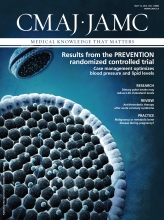For references, please see Appendix 2, available at www.cmaj.ca/lookup/suppl/doi:10.1503/cmaj.130972/-/DC1
Carbon monoxide is an imperceptible but lethal toxin
Carbon monoxide (CO) is an imperceptible gas produced by the incomplete combustion of carbon-based compounds. Although hemoglobin binds to CO 240 times more avidly than it binds to oxygen, it also exerts toxicity by other less well-appreciated mechanisms. It binds to cytochromes throughout the body, produces reactive oxygen species and peroxidates brain lipids, among other effects.1
Carbon monoxide poisoning is common, but most cases are preventable
Common sources of CO exposure include malfunctioning heating systems, improperly ventilated motor vehicles, generators, grills, stoves and residential fires. Exposure to CO can produce acute or chronic toxicity, and preventive measures should include the use of CO detectors designed to trigger after short-duration exposure to high levels or after longer-duration exposure to lower levels.1,2 In homes with fuel-burning appliances, CO detectors should be on the same level as the appliance and the levels above and below; the alarm should be easily heard from all bedrooms, minimizing the risk of sustained CO exposure during sleep.2
The effects of CO poisoning are nonspecific, making diagnosis difficult
The signs and symptoms of CO poisoning (e.g., headache, fatigue, presyncope) are common to many other conditions, with the central nervous system and cardiovascular system being most prominently affected (Appendix 1, available www.cmaj.ca/lookup/suppl/doi:10.1503/cmaj.130972/-/DC1). No sign or symptom is pathognomonic. Flushed cheeks are sometimes touted as a clue to CO poisoning; however, this feature is neither sensitive nor specific to the diagnosis.3 Oxygen saturation measurements by use of routine pulse oximetry and arterial blood gas analysis are typically normal, and the diagnosis is made by detecting elevated carboxyhemoglobin levels on cooximetry or with multiwave pulse oximetry.4
The goal of treatment is the prevention of neurologic sequelae
After removal from exposure, treatment consists of 100% oxygen, which accelerates the elimination of carboxyhemoglobin. Hyperbaric oxygen (HBO) therapy further accelerates elimination, but the extent to which it prevents neurologic sequelae, and whether the risks and costs of treatment are justified, are unclear.5 Some authorities recommend specific indications for HBO therapy (e.g., severe CO poisoning, prolonged exposure, pregnancy or carboxyhemoglobin levels of ≥ 25%);1 however, there is no absolute indication for HBO therapy for patients with CO poisoning.
Concomitant cyanide exposure should be considered for those exposed to residential fires
Cyanide is produced by the combustion of synthetic materials and may be a contributing cause of death in victims of residential fires. Cyanide directly and rapidly inhibits mitochondrial function, and its presence should be considered for patients with altered mental status, cardiovascular instability and lactic acidosis. In such cases, antidote therapy should include hydroxocobalamin and sodium thiosulfate. Amyl nitrite and sodium nitrate should be avoided for those with concurrent CO poisoning, because these compounds work by inducing methemoglobin formation, which furthers reduces the oxygen content of blood in patients with carboxyhemoglobin accumulation.6
Footnotes
-
Competing interests: None declared.
-
This article has been peer reviewed.








